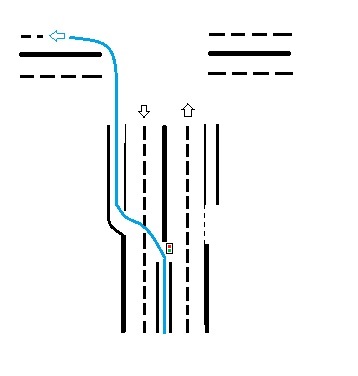Few traffic maneuvers are as risky as left turns. Intersecting vehicles, moving traffic, and pedestrians require drivers to keep track of multiple variables. In general, drivers are more likely to experience a collision while attempting a left turn, but not all left turns are the same. In this post, we will cover displaced left turns and their implications for traffic safety, talk about some strategies for navigating this type of maneuver, go over the various considerations drivers should make when they encounter a displaced left turn, and discuss the importance of education when it comes to displaced left turns and other traffic infrastructure.
What are displaced left turns?
Displaced left turns are a specific type of traffic configuration where the left turn lane is separate from the lanes of continuing traffic. Drivers must proceed ahead in a separate lane before making their turn as opposed to making their turn directly from the leftmost lane of their side of the road. Drivers must cross over to the opposite side of the road in advance of making their turn. This may seem hard to visualize, so here is a helpful diagram to give you a better picture of what displaced left turns look like:

There are various reasons for implementing displaced left turns. Two common reasons are the following:
- Safety Considerations: By keeping through-traffic separate from left-turn traffic, displaced left turns are meant to reduce side-impact collisions as well as head-on collisions at intersections. This separation prevents left-turning vehicles from feeling pressured to turn hastily because through-traffic is backed up behind them.
- Efficiency of Traffic Flow: Displaced left turns aim to improve traffic flow by reducing congestion at the intersection. Traffic can continue through the intersection while left-turning vehicles are funneled into a separate lane.
Apart from safety and efficiency, there are many benefits as well as some challenges when it comes to displaced left turns:
- Improved Intersection Capacity: Like improving overall traffic flow, intersection capacity is increased when displaced left turns are implemented. The diversion of left-turning vehicles allows the remaining lanes to be open for through traffic. Without left-turning vehicles causing congestion, more through traffic can cross the intersection during a green light.
- Advanced Planning and Execution: One potential challenge associated with displaced left turns is that drivers must anticipate their turn and position themselves in the proper lane well in advance. Drivers must position themselves in the designated lane and wait for a green light to cross over to the leftmost part of the intersection. This means that drivers must be extra attentive, drive strategically, and look out for traffic signs and signals.
- Awareness and Education: Not all drivers are familiar with displaced left turns. Drivers who are unfamiliar with the intersection might be especially confused by the displaced lane. It is important that proper education and signage are available to drivers before new infrastructure is implemented to avoid confusion.
Tips for Navigating Displaced Left Turns:
- Observe Traffic Signs and Signals: In the presence of a displaced left turn, by close attention to any traffic signs or markers. These signs will help you maneuver safely and guide you toward the correct lane.
- Plan and Anticipate: You should begin preparing for your turn well in advance of the intersection. Be vigilant to ensure that you are in the correct lane for your displaced left turn. If you miss the correct lane, never try to turn illegally in the wrong lane. Proceed to the intersection and make your turn at a later point.
- Yield to Oncoming Traffic: Oftentimes, displaced left turn lanes are not positioned all the way to the left of oncoming traffic lanes. This means that, just like traditional left turns, you may have to yield to oncoming traffic. Be cautious, and only proceed with your turn if there is a safe gap in traffic that gives you enough time to traverse the intersection.
- Communicate and Stay Alert: Remain attentive to the movements of the other vehicles around you. Remember to use your turn signals well in advance of your turn and communicate with other drivers. Prepare to use your brakes if necessary and maintain a safe following distance.
- Look Out for Lane Changes: Displaced left turns require an initial lane change to reach the point where you would cross the opposite side of the road. When you change lanes, stay mindful of the flow of traffic. Always check your blind spot, and do not try to cross multiple lanes at once. Only make your lane change if it is safe to do so.
- Practice Patience: Like traditional left turns, it can be very dangerous to turn hastily. You should not only be aware of oncoming traffic but also be aware of pedestrians in the intersection. Remaining patient allows you to spot obstacles in time to make a safe stop.
- Drive Defensively: Always utilize defensive driving techniques when making a complex maneuver. Due to all the changing variables associated with left turns of any kind, you should always be ready to stop safely if you must.
- Stay Informed: Familiarize yourself with the local road conditions and traffic regulations. Some intersections are easier to navigate than others, and you may want to avoid certain intersections that pose a particular challenge.
The Importance of Driver Education and Infrastructure:
New infrastructure can cause driver confusion which can increase the risk of accidents. When it comes to displaced left turns, driver education and awareness are crucial. Road authorities should implement clear signage and road markings well in advance of the turn. Like the implementation of roundabouts in America, it may take time for people to become comfortable with new infrastructure.
Displaced left turns have various benefits, but they can present unique challenges to drivers. The main challenge with this type of maneuver is that it requires advanced planning. By following defensive driving tips and remaining attentive, drivers can navigate these types of turns more safely. Remember to adhere to traffic rules and look out for signage and road markings.




